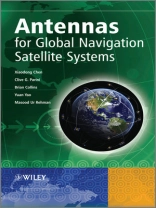This book addresses the fundamentals and practical implementations of antennas for Global Navigation Satellite Systems (GNSS)
In this book, the authors discuss the various aspects of GNSS antennas, including fundamentals of GNSS, design approaches for the GNSS terminal and satellite antennas, performance enhancement techniques and effects of user’s presence and surrounding environment on these antennas. In addition, the book will provide the reader with an insight into the most important aspects of the GNSS antenna technology and lay the foundations for future advancements. It also includes a number of real case studies describing the ways in which antenna design can be adapted to conform to the design constraints of practical user devices, and also the management of potential adverse interactions between the antenna and its platform.
Key Features:
- Covers the fundamentals and practical implementations of antennas for Global Navigation Satellite Systems (GNSS)
- Describes technological advancements for GPS, Glonass, Galileo and Compass
- Aims to address future issues such as multipath interference, in building operation, RF interference in mobile
- Includes a number of real case studies to illustrate practical implementation of GNSS
This book will be an invaluable guide for antenna designers, system engineers, researchers for GNSS systems and postgraduate students (antennas, satellite communication technology). R&D engineers in mobile handset manufacturers, spectrum engineers will also find this book of interest.
İçerik tablosu
Preface ix
1 Fundamentals of GNSS 1
1.1 History of GNSS 1
1.2 Basic Principles of GNSS 2
1.2.1 Time-Based Radio Navigation 2
1.2.2 A 3D Time-Based Navigation System 5
1.3 Operation of GPS 8
1.4 Applications Including Differential GPS 15
References 18
2 Fundamental Considerations for GNSS Antennas 21
2.1 GNSS Radio Wave Propagation 21
2.1.1 Plane Waves and Polarisation 21
2.1.2 GNSS Radio Wave Propagation and Effects 23
2.1.3 Why CP Waves in GNSS? 26
2.2 Antenna Design Fundamentals 26
2.2.1 Antenna Fundamental Parameters 26
2.2.2 LP Antenna Design and Example 29
2.3 CP Antenna Design 31
2.3.1 CP Antenna Fundamentals and Types 31
2.3.2 Simple CP Antenna Design Example 35
2.3.3 Technical Challenges in Designing GNSS Antennas 36
References 40
3 Satellite GNSS Antennas 41
3.1 Navigation Antenna Requirements 41
3.2 Types of Antenna Deployed 41
3.3 Special Considerations for Spacecraft Antenna Design 50
3.3.1 Passive Intermodulation Effects 50
3.3.2 Multipactor Effects 52
References 52
4 Terminal GNSS Antennas 55
4.1 Microstrip Antenna for Terminal GNSS Application 55
4.1.1 Single-Feed Microstrip GNSS Antennas 55
4.1.2 Dual-Feed Microstrip GNSS Antennas 60
4.1.3 Design with Ceramic Substrate 64
4.2 Spiral and Helix GNSS Antennas 66
4.2.1 Helix Antennas 66
4.2.2 Spiral Antennas 71
4.3 Design of a PIFA for a GNSS Terminal Antenna 73
References 79
5 Multimode and Advanced Terminal Antennas 81
5.1 Multiband Terminal Antennas 81
5.1.1 Multiband Microstrip GNSS Antennas 82
5.1.2 Multiband Helix Antennas for GNSS 88
5.2 Wideband CP Terminal Antennas 95
5.2.1 Wideband Microstrip Antenna Array 95
5.2.2 High-Performance Universal GNSS Antenna Based on Spiral Mode Microstrip Antenna Technology 96
5.2.3 Wideband CP Hybrid Dielectric Resonator Antenna 96
5.2.4 Multi-Feed Microstrip Patch Antenna for Multimode GNSS 98
5.3 High-Precision GNSS Terminal Antennas 102
References 109
6 Terminal Antennas in Difficult Environments 111
6.1 GNSS Antennas and Multipath Environment 111
6.2 Statistical Modelling of Multipath Environment for GNSS Operation 113
6.2.1 GPS Mean Effective Gain (MEGGPS) 114
6.2.2 GPS Angle of Arrival Distribution (Ao AGPS) 116
6.2.3 GPS Coverage Efficiency (ηc) 117
6.3 Open Field Test Procedure 119
6.3.1 Measurement of GPS Mean Effective Gain 119
6.3.2 Measurement of GPS Coverage Efficiency 120
6.3.3 Measurement Set-Up 120
6.4 Performance Assessment of GNSS Mobile Terminal Antennas in Multipath Environment 121
6.4.1 Design of Tested GPS Antennas 122
6.4.2 Comparison Based on Simulated and Measured 3D
Radiation Patterns 127
6.4.3 Comparison Based on Measured 3D Radiation Patterns and Actual Field Tests 129
6.5 Performance Dependence on GNSS Antenna Orientation 133
6.6 Performance Enhancement of GNSS Mobile Terminal Antennas in Difficult Environments 139
6.6.1 Assisted GPS 140
6.6.2 GPS Signal Reradiation 140
6.6.3 Beamforming 141
6.6.4 Diversity Antennas 141
References 147
7 Human User Effects on GNSS Antennas 149
7.1 Interaction of Human Body and GNSS Antennas 149
7.2 Effects of Human Body on GNSS Mobile Terminal Antennas in Difficult Environments 150
7.2.1 Design of Tested GPS Antennas 151
7.2.2 Effects of Human Hand and Head Presence 151
7.2.3 Effects of Complete Human Body Presence 166
References 179
8 Mobile Terminal GNSS Antennas 181
8.1 Introduction 181
8.2 Antenna Specification Parameters 183
8.2.1 Polarisation 183
8.2.2 Radiation Patterns 184
8.2.3 Impedance 185
8.2.4 Gain/Efficiency 186
8.2.5 Weight 187
8.2.6 Bandwidth 187
8.2.7 Phase Performance 188
8.3 Classification of GNSS Terminals 188
8.3.1 Geodetic Terminals 188
8.3.2 Rover Terminals 188
8.3.3 General Purpose Mobile Terminals 189
8.4 Antenna Designs for Portable User Equipment 190
8.4.1 Short Quadrifilar Helices 190
8.4.2 Patch Antennas 191
8.4.3 Smaller Antennas 192
8.5 The Function of the Platform 192
8.5.1 Antenna Efficiency, Gain and Noise 193
8.6 Comparing Antenna Performance on UEs 194
8.6.1 Drive Testing 194
8.6.2 Non-Antenna Aspects of Performance 195
8.7 Practical Design 197
8.7.1 Positioning the GNSS Antenna on the Application Platform 197
8.7.2 Evaluating the Implementation 200
8.8 Case Studies 201
8.8.1 Measurement System 201
8.8.2 Case 1: Modified PIFA on Face of Small PCB 202
8.8.3 Case 2: Meandered Dipole Antenna on Top Edge of Small PCB 203
8.8.4 Case 3: Modified PIFA above LCD Display on Smart-Phone-Size Device 204
8.8.5 Case 4: Moving Modified PIFA from One to Adjacent Corner of PCB 205
8.8.6 Cases 5 and 6: Effects of Platform Electronics Noise 205
8.9 Summary 206
References 206
Appendix A Basic Principle of Decoding Information from a CDMA Signal 207
Appendix B Antenna Phase Characteristics and Evaluation of Phase Centre Stability 211
Index 215
Yazar hakkında
Professor Xiaodong Chen, Queen Mary, University of London, UKXiaodong Chen is a Professor in Microwave Engineering at Queen Mary, University of London. His research interests are in microwave devices and antennas, wireless communications and bioelectromagnetics.
Professor Clive G. Parini, Queen Mary, University of London, UKClive G. Parini heads the Antenna & Electromagnetics Research Group. His research topics including array mutual coupling, array beam forming, antenna metrology, microstrip antennas, millimetrewave compact antenna test ranges, millimetrewave integrated antennas, metamaterials and on-body communications.
Professor Brian Collins, Queen Mary, University of London, UKBrian Collins has designed antennas for a very wide range of applications, from radio and TV broadcast antennas to base station and handset antennas.
Dr. Yuan Yao, Beijing University of Posts and Telecommunications, China Yuan Yao received Ph. D degree in electronic engineering from Tsinghua University, China. His research interests include antenna design, antenna array analysis and design, and microwave circuits design.
Masood Ur Rehman, Queen Mary, University of London, UKMasood Ur Rehman is a final year Ph D student in Queen Mary, University of London, UK. He received B.Sc (Hons.) degree in Electronics and Communication Engineering from University of Engineering and Technology, Lahore, Pakistan in 2004 and completed his M.Sc in Wireless Networks at Queen Mary, University of London in 2006.












